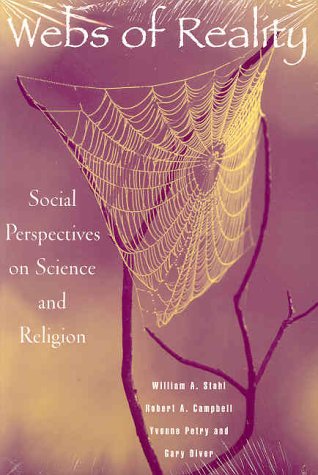Webs of Reality: Social Perspectives on Science and Religion
William A Stahl, Robert A. Campbell and Yvonne Petry and Gary Diver
Rutgers University Press: New Brunswick
2002
0813531071 (pb); 0813531071 (hb)
$22.00 (pb); $59.00 (hb)
192
 Webs of Reality is a jointly authored book about science and religion written from Roman Catholic, Lutheran, Presbyterian and Anglican perspective, continuing a discussion which began in the 1994 Science and Religion Course Program sponsored by the John Templeton Foundation. The authors have received awards to assist them in course development and the book has been framed with teaching goals in view. Each chapter is a well-contained unit in its own right and overall the book is an engaging and elaborate bibliographical essay.
Webs of Reality is a jointly authored book about science and religion written from Roman Catholic, Lutheran, Presbyterian and Anglican perspective, continuing a discussion which began in the 1994 Science and Religion Course Program sponsored by the John Templeton Foundation. The authors have received awards to assist them in course development and the book has been framed with teaching goals in view. Each chapter is a well-contained unit in its own right and overall the book is an engaging and elaborate bibliographical essay.
Formally, the book's sections are derived from Max Weber's concepts (pp. 14-20) but the argument is not a sociological discussion per se. With its wealth of trans- disciplinary material presented in a neat, readable and winsome fashion, Webs of Reality will be useful for teaching the sociological analysis of the science- religion problem and for analyzing the many and varied debates that arise from time to time. The rendering of Max Weber's doctrine of "value freedom" is vague, lacking any appreciation for Weber's protest against the Kaiser-cult in Imperial German universities. As well, the claim of the authors to be using a functionalist approach is made with these words - "rather than examining what science and religion supposedly are, we analyze what they do" (p.23). This naïve interpretation does not do justice to the functionalist paradigm in sociology.
The argument is diffuse but then so is the issue which the authors confront. The sub- title "Social perspectives on science and religion" captures their approach. Their well- ordered eclecticism is organised under various "sociological" headings provided by Weber's concepts of soteriology, saintliness, magic, theodicy, and mystery/objectivity. The book discusses how natural science (geology and evolutionary biology) has related to theology and much more. Fundamentalist creationism versus evolutionism is placed on a wider canvas. Chapter 8, The Moral of the Dinosaur, involves a perceptive discussion of how extinction has been investigated, building upon the earlier discussion of the history and historiography of science in Chapter 2, Writing the History of Science. Chapter 6 As if by Magic is a hard hitting exposé of scientism as magic, identifying the medical science double standard which asserts causation in one case (ie HIV/AIDS) and denies it in an other (ie an apparently well-documented study about the effect of Prayer in nursing settings). Hermeneutics and technology are also given some consideration.
In an engaging chapter (Writing the History of Science) the authors state: "Koyre's study of Galileo was first published in 1939. When the English translation appeared in 1978, the stage was set for a reassessment of the relationship between religion and science" (p.46). This is a very strange remark. Had not Koyré, on the basis of his study, already reassessed the relationship between science and religion? Was Koyré's work without an impact in his own academic tongue and beyond where bi-lingual academics reassessed Galileo by reading his work? Is historical development in science to be dated from when work becomes available in the English language? This is at odds with trenchant remarks made elsewhere indicating the need for a sharp distinction between authentic scientific developments and what is said to be so in "popular science" magazines or the propaganda machines of governments and corporations with their huge R&D investments. A more nuanced contribution from bi- lingual Canada could have been expected.
There is no discussion of whether theology is a science, nor is there even any passing reference to Christian sociology or sociology based in other religious world-views. The impact of Islam upon western science, and Islamic sociology does not figure in the discussion. What references are made to deism are somewhat inconsequential. The writers strive mightily to relate scientific self-criticism to religious reflection (wonder, awe and the answer to the "Who am I? question) but they do so by keeping them in separate compartments. There are two unanswered questions from Webs of Reality: How do communities of scientists, in whatever discipline and however organised, derive inspiration for their labour if not from some or other religious orientation? And how can self-critical reflection occur in science without it being an expression of religious consciousness?

